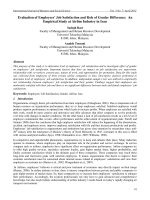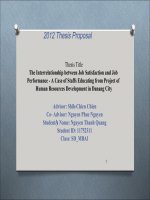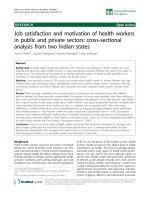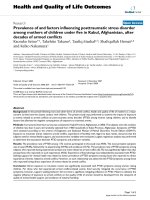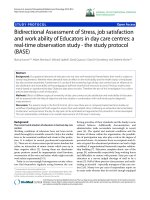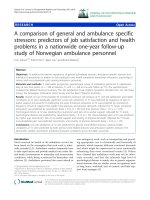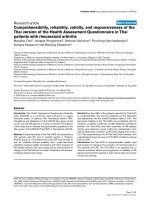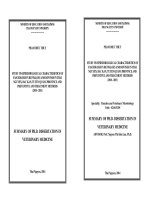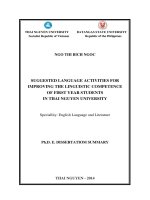Factors influencing job satisfaction and work motivation of the facuties at the universities and colleges in thai nguyen city
Bạn đang xem bản rút gọn của tài liệu. Xem và tải ngay bản đầy đủ của tài liệu tại đây (1.51 MB, 138 trang )
FACTORS INFLUENCING JOB SATISFACTION AND WORK
MOTIVATION OF THE FACULTIES AT THE UNIVERSITIES
AND COLLEGES IN THAI NGUYEN CITY
A DISSERTATION PAPER
Presented to
the Faculty of the Graduate Program
of the College of Arts and Sciences
Central Philippine University, Philipppines
In Collaboration with
Thai Nguyen University, Vietnam
By
LE THU HA
APRIL, 2018
2i
DECLARATION
I certify that this is my own research. The data stated in the thesis is true, all citations
are indicated origin. The research results of the dissertation were published in the scientific
journal, not identical with any other works.
The author of the thesis
LE THU HA
3i
LỜI CAM ĐOAN
Tôi cam kết rằng đây là nghiên cứu của riêng tôi. Các dữ liệu được nêu trong luận án
là trung thực, tất cả các trích dẫn được chỉ rõ nguồn gốc. Các kết quả nghiên cứu của luận án
đã được công bố trên tạp chí khoa học, không trùng với bất kỳ công trình nào khác.
Tác giả của luận án
LÊ THU HÀ
iv
4
ACKNOWLEDGEMENT
The researcher would like to acknowledge and appreciated to the following persons
who wholeheartedly devoted and helped make this piece of work a reality:
To Associate Professor Ph.D. Nguyen Thi Gam for her advices, guidance, supervision,
suggestions and precious time in enthusiastically reading and checking the manuscript,
providing the author useful materials;
To the chancellors of University of Economics and Business Administration for their
enthusiasm support and flexibility during the study program.
Furthermore, The researcher appreciate my parents, my beloved husband and friends,
who have been continuously supported and encouraged me throughout doctoral learning
journey. Without them, this dissertation would not have been completed successfully..
LE THU HA
iv
5
LỜI CẢM ƠN
Nhà nghiên cứu muốn bày tỏ lòng biết ơn sâu sắc đến những người đã hết lòng cống
hiến và giúp luận án này thành hiện thực:
Xin bày tỏ lòng biết ơn sâu sắc tới Phó giáo sư, Tiến sĩ Nguyễn Thị Gấm, người đã
cho lời khuyên, hướng dẫn, giám sát, đề xuất và thời gian quý báu của mình trong việc nhiệt
tình đọc và kiểm tra bản thảo, cung cấp cho tác giả những tài liệu hữu ích;
Tới các lãnh đạo của Trường Đại học Kinh tế và Quản trị Kinh doanh vì sự hỗ trợ
nhiệt tình và linh hoạt của họ trong chương trình học.
Cuối cùng, xin bày tỏ lòng biết ơn sâu sắc tới cha mẹ, người chồng và bạn bè yêu quý
của tôi, những người đã liên tục hỗ trợ và khuyến khích tôi trong suốt quá trình học tiến sĩ.
Không có họ, luận án này sẽ không được hoàn thành thành công.
LÊ THU HÀ
6vi
TABLE OF CONTENTS
ACKNOWLEDGEMENT
iv
.........................................................................................................
LỜI
CẢM
ƠN............................................................................................................................. v TABLE
OF CONTENTS........................................................................................................... vi LIST
OF TABLES...................................................................................................................viii LIST
OF
FIGURES
...................................................................................................................
ix
LIST OF ABBREVIATIONS AND ACRONYMS.................................................................... x
ABSTRACT ...............................................................................................................................ii
CHAPTER I
INTRODUCTION ............................................................................................ 1
1.1. Background and Rationale of the Study ..............................................................................
1
1.2. Objectives of the Study ....................................................................................................... 3
1.3. Theoretical Framework....................................................................................................... 4
1.4. Conceptual Framework...................................................................................................... 10
1.5. The Operational Definition of Variables ...........................................................................
11
1.6. The Significance of the Study ........................................................................................... 15
1.7. Scope and Delimitations of the Study ............................................................................... 16
CHAPTER II REVIEW OF RELATED LITERATURE AND STUDIES............................ 17
2.1. Job Satisfaction.................................................................................................................. 17
2.2. Work Motivation ............................................................................................................... 18
2.3. Tools of work motivation and job satisfaction .................................................................. 20
2.5. Summary of the Literature Review ................................................................................... 29
CHAPTER III
30
RESEARCH METHODOLOGY ................................................................
3.1. Research Design ................................................................................................................
30
3.2. Location of the Study ........................................................................................................ 31
3.4. Research Instrument ..........................................................................................................
33
3.5. Data Collection Procedure................................................................................................. 44
3.6. Data Analysis..................................................................................................................... 44
3.7. Ethical Consideration ........................................................................................................ 45
CHAPTER IV
DATA PRESENTATION, ANALYSIS AND INTERPRETATION ......... 45
4.1. Respondents‟ Characteristics............................................................................................. 46
7vi
4.2. Descriptive statistics analysis ............................................................................................
50
4.3. Exploratory Factor Analysis EFA .....................................................................................
56
4.5. Correlation Analysis ..........................................................................................................
65
8vi
4.6. Multiple linear regression analysis .................................................................................... 66
4.7. Difference of job satisfaction follow individual characteristics test ................................. 73
4.8. Difference of work motivation follow individual characteristics test ............................... 75
4.9. Summary............................................................................................................................ 76
CHAPTER IV
SUMMARY, CONCLUSIONS AND RECOMMENDATIONS ............... 78
5.1. Conclusions ....................................................................................................................... 79
5.2. Recommendations ............................................................................................................. 80
REFERENCES ......................................................................................................................... 84
APPENDIX 1: Survey Questionnaire ...................................................................................... 88
APPENDIX 2: Frequency Table of the sample....................................................................... 92
APPENDIX 3: Descriptive Statistics of the sample................................................................. 93
APPENDIX 4: Reliablibity Test of Scales ............................................................................... 94
APPENDIX 5: Result of factor analysis with independent variables ..................................... 98
APPENDIX 6: Difference of job satisfaction follow individual characteristics test ............. 101
APPENDIX 7: Difference of work motivation follow individual characteristics test ........... 108
88
LIST OF TABLES
Table 3.1 Study Sample Size.................................................................................................... 33
Table 3.2. The Likert scale ....................................................................................................... 34
Table 3.3. List of variables and initial items in the survey instrument..................................... 35
Table 3.4. Value and significance level of the Cronbach's alpha coefficient........................... 38
Table 3.5. Cronbach'alpha analysis results............................................................................... 38
Table 3.6. Results of reliability test of scales ........................................................................... 42
Table 4.1. Descriptive statistics analysis of salary and benefit ................................................ 50
Table 4.2. Descriptive statistics analysis of training and promotion........................................ 51
Table 4.3. Descriptive statistics analysis of the relationship with superiors ............................ 52
Table 4.4. Descriptive statistics analysis of the relationship with colleagues ..........................
52
Table 4.5. Descriptive statistics analysis of the recognition..................................................... 53
Table 4.6. Descriptive statistics analysis of the working conditions........................................ 54
Table 4.7. Descriptive statistics analysis of job satisfaction .................................................... 54
Table 4.8. Descriptive statistics analysis of work motivation .................................................. 55
Table 4.9. Result of the Factor Analysis of Independent Variables ......................................... 57
Table 4.10. Names and abbreviations of variables after EFA .................................................. 58
Table 4.11. EFA with scales of Salary and benefit .................................................................. 58
Table 4.12. EFA with scales of Training and promotion ......................................................... 59
Table 4.13. Factor Analysis of Relationship with superiors .................................................... 60
Table 4.14. Factor Analysis of Relationship with colleagues .................................................. 61
Table 4.15. Factor Analysis of Recognition ............................................................................. 61
Table 4.16. Factor Analysis of Working conditions................................................................ 62
Table 4.17. Factor Analysis of Job satisfaction....................................................................... 63
Table 4.18. Factor Analysis of Work motivation .................................................................... 64
Table 4.19. Correclation coeefficients...................................................................................... 65
Table 4.20. Regression model of Job satisfaction variables..................................................... 66
Table 4.21. Regression model of Work Motivation variables.................................................. 69
Table 4.22. Regression model of Job satisfaction variable and Work Motivation variable..... 72
Table 4.23. Results of difference of job satisfaction by “Gender” test .................................... 74
Table 4.24. Result of the T test between “universities” and “colleges” ................................... 74
Table 4.25. Results of difference of work motivation by “Gender” test .................................. 75
Table 4.26. Result of the T test work motivation between “universities” and “colleges” ....... 76
99
LIST OF FIGURES
Figure 1.1.Maslow's hierarchy of needs ..................................................................................... 6
Figure 1.2. Two Factor Theory – Herzberg................................................................................ 8
Figure 1.3. Basic expectancy model (Lunenburg F. C., 2011)................................................... 9
Figure 1.4. Conceptual Framework .......................................................................................... 10
Figure 3.1. Research Process.................................................................................................... 30
Figure 3.2. Map of Thai Nguyen Province............................................................................... 31
Figure 4.1. Distribution of the Respondents by Gender ........................................................... 46
Figure 4.2. Distribution of faculties respondents by Age group .............................................. 47
Figure 4.3. Distribution of faculties by Highest Academic Qualifications .............................. 48
Figure 4.4. Distribution of faculties by teaching experience.................................................... 49
Figure 4.5. Distribution of faculties by Income (VND) ........................................................... 49
1
0
LIST OF ABBREVIATIONS AND ACRONYMS
ANOVA
Analysis of Variance
EFA
Exploratory Factor Analysis
KMO
Kaiser – Meyer – Olkin
Sig.
Significance
SPSS
Statistical Package for the Social Sciences
TNU
Thai Nguyen University
VIF
Variance Inflation Factor
ABSTRACT
The research on the factors affecting the satisfaction and motivation of faculties at
universities and colleges in Thai Nguyen City has been conducted to assess the current state
and determine the factors (salary and benefit, training and promotion, relationship with
superior, relationship with colleagues, recognition and working conditions) that are associated
with job satisfaction and work motivation among faculties.
The research was conducted with 324 respondents, randomly selected lecturers
allocated proportionately to the eight universities and colleges in Thai Nguyen City. All the
data collected were processed using SPSS 16. The survey data were tested to examine its
reliability by using the Cronbach‟s Alpha and Exploratory Factor Analysis (EFA) was used to
reduce the instrument for regression model. The initial six factors with 38 items were reduced
into six factors with 34 items after the EFA. Analysis made use of descriptive statistics and
Multiple Regression Analysis, T-test and Analysis of Variance (ANOVA) to test the
hypotheses of the study.
Based on the results of the survey, the following are the major findings of the study:
Most the majority of the respondents were females (69%), young and have years old
below 36 (68.3%), married (87,3%), academic level master, doctors and associate professors,
professors (92.4%), work experience less than ten years (70.1%) and with a monthly income
below 7.5M VND (88.5%).
The research findings showed that five out of six variables in the model have a
positive relationship with job satisfaction. They are salary and benefit, relationship with
superior, relationship with colleagues, recognition and working conditions. In particular,
“Working conditions” has the greatest impact.
The research findings showed that four out of six variables in the model have a
positive relationship with work motivation.They are salary and benefit, relationship with
superior, recognition and working conditions. In particular, “Working conditions” has the
greatest impact.
The results of the study also showed that job satisfaction of the faculties was
positively influenced to their work motivation.
No significant differences in the job satisfaction and work motivation of respondents
according to their gender, age, marital status, income, work place.
Based on the research findings, the researcher proposed some recommendations to
improve job satisfaction and motivation of faculties working at universities and colleges in
Thai Nguyen City.
1
CHAPTER I
INTRODUCTION
1.1. Background and Rationale of the Study
Creating job satisfaction and work motivation has increasingly been of great interest.
job satisfaction and work motivation have been considered as a main key to the success of
every organisation in the market economy. To use human resources appropriately and
effectively in one organisation as well as help employees maximise their own capabilities,
employee‟s job satisfaction is one of the most important factors deciding the organisations‟
success. If employees are satisfied they will be motivated to work harder for the organization.
Once having motivation to work, employees will work more actively and assure long-term
working for organisations. As a results, it leads to better work performance and higher
productivity.
In “Vietnam‟s social- economic development strategy for a period of 2011 - 2020”, it
is oriented that "Developing and improving the quality of human resources, especially highquality human resources is a strategic breakthrough" (Socialist Republic of Viet Nam
government portal, 2012). Hence, set in the education development strategy for 2011 - 2020
period, overall objective is stated as follows:
"By 2020, Vietnam’s education system is innovated basically and comprehensively
towards standardisation, modernisation, socialisation, democratisation and international
integration. The quality of education and training is improved in a comprehensive manner,
which focuses on: the education on ethics, lifestyle, capacities of creation, practice, foreign
languages and information technology; meeting human resource needs, especially highquality human resources for the process of industrialisation and modernisation of the country
together with building the knowledge economy; ensuring social equality in education and
long-term learning opportunities for every citizen, gradually forming a learning society."
(Socialist Republic of Viet Nam Government Porta, 2012)
Also, the education development strategy from 2011 to 2020 has suggested measures
to develop teachers and education managing administrators:
“carrying out policies with physical and mental priorities to motivate teachers and
education administrators, establishing special policies to attract teachers, scientists,
professionals having experiences and prestige domestically and overseas to participate in the
development of education " (Socialist Republic of Viet Nam Government Porta, 2012).
2
Indicated from the strategy of education development, Vietnam has viewed the
national education development as a leading policy, in which there is a great contribution of
the teacher and lecturer resources. For each university, the high-quality resource of faculties is
also an important factor influencing the quality of education and training, helping each unit
create competitive advantages to attract students, building up its own reputation and trust
from students, families and the society.
Currently, Thai Nguyen Province has ten colleges and eight universities (Portal of
Thai Nguyen province,VietNam, 2017) where is seen as a center of training, scientific
research, technology transfer in the Northern Midland and Mountainous area of Vietnam. The
universities and colleges have the mission of training high - quality human resources for the
process of the society reconstruction and social- economic sustainable development for
Northern Midland and Mountainous region (TNU, 2016). Under this mission, Thai Nguyen
has built up human resource development strategies, particularly in teaching staff resource.
The development strategy of teaching staffs has been identified as the core objective affecting
the quality of education and scientific research of the educational establishments.
However, as many other professions, the education and training quality provided by
teaching staffs depends significantly on their job satisfaction and work motivation. A study of
Ofoegbu in Nigeria states that, motivation of teachers plays an important part in effectiveness
classroom and school improvement. As such, (Ofoegbu, 2004) argued, teacher motivation
enhances the effectiveness of classrooms and improvement of schools. (Legal Normative
Document, 2017)
Up to date, there is no published research studying this issue in the province of Thai
Nguyen. In the meantime, these perspectives listed above leads to the importance of studying
factors which influence job satisfaction and work motivation of faculties working in
universities and colleges in the Thai Nguyen Province. Therefore, this kind of research is to
meet the requirement of high- quality human resources development strategy for every
university following Vietnam‟s education and training development strategy for 2011- 2020
period.
3
1.2. Objectives of the Study
Overall objective
The purpose of the study was to examined the factors that influence job satisfaction
and work motivation among faculties working for universities and colleges in the area of Thai
Nguyen city. Based on the research findings, the researcher was proposed some
recommendations and policy implications to improve job satisfaction and motivation of
faculties working for Thai Nguyen‟s universities and colleges. These recommendations are
hoped to contribute to the implementation of general strategic objectives of Vietnam in the
process of the international integration.
Specific objectives
1. To describe respondents' profile according to gender, age group, highest academic
qualification, teaching experience and income.
2. To assess the level of job satisfaction and work motivation of faculty working at
universities and colleges in the city of Thai Nguyen.
3. To identify factors influencing job satisfaction of faculty in universities and
colleges in Thai Nguyen City.
4. To identify factors influencing work motivation of faculty in universities and
colleges in Thai Nguyen City.
5. To determine the relationship between job satisfaction and work motivation of
faculty working at universities and colleges in the City of Thai Nguyen.
6. To compare the differences in job satisfaction among faculties working in
universities and colleges in Thai Nguyen City according to respondent‟s profile.
7. To compare the differences in work motivation among faculties working in
universities and colleges in Thai Nguyen City according to respondent‟s profile.
8. To propose some recommendations and policies with a view of increasing the level
of employee work satisfaction and motivation, specifically faculties working in universities
and colleges in Thai Nguyen City.
* Hypothesis of the Study
Based on the inferential objectives 4 to 7 of the study, the following hypotheses were
tested at 0.05 level of significance:
H1: There is no significant relationship between salary, benefit and job satisfaction.
H2: There is no significant relationship between training, promoting and job
4
satisfaction.
H3: There is no significant relationship between relationship with superiors and
job satisfaction.
H4: There is no significant relationship between relationship with colleagues and job
satisfaction.
H5: There is no significant relationship between recognition and job satisfaction.
H6: There is no significant relationship between working conditions and
job satisfaction.
H7: There is no significant relationship between salary, benefit and work motivation.
H8: There is no significant relationship between training, promoting and work
motivation.
H9: There is no significant relationship between relationship with superiors and work
motivation.
H10: There is no significant relationship between relationship with colleagues
and work motivation.
H11: There is no significant relationship between recognition and work motivation.
H12: There is no significant relationship between working conditions and work
motivation.
H13: There is no significant relationship between job satisfaction and work motivation
H14: There is no significant differences in the job satisfaction according to gender.
H15: There is no significant differences in the job satisfaction according to work place
(between the universities and the colleges).
H16: There is no significant differences in the work motivation according to gender
H17: There is no significant differences in the work motivation according to
work place (between the universities and the colleges).
1.3. Theoretical Framework
1.3.1. Maslow's Hierarchy of Needs theory
This is one of the most popular theories of work motivation. According to American
psychologist named Abrаhаm Mаslow, human beings have different needs shaped a hierarchy
ascending from low to high. When low-level needs are satisfied, a need with higher level will
become a driving force. Once a need is met, another one will appear. As a result, human
beings always have desires to be met, which encourage individuals to carry out certain jobs
tofulfill their needs. With drawn from Maslow‟s study, when a group of needs are satisfied,
these needs no longer motivate an individual‟s action anymore. Suggested by this author,
5
there are five levels of needs divided into two groups, low level and high level. These levels
are ordered following a hierarchy of needs displayed in a pyramid shape. The lower order
group of needs consists of physiological, safety, love and belonging needs while the higher
order needs are esteem and self-actualisation. These needs are explained in details as
followed:
Physiological needs Physiological needs are at the lowest level of Maslow‟s hierarchy.
This is the basic requirements of foods, water, shelters, relaxation, transportation and so on
for human beings tosurvive physically. When these requirements are not met, a body of
human is not able to function in a proper manner and will eventually fail. Therefore,
physiological needs are deemed to play the most significant role so they ought to be met first.
Applied in the working environment, employees need to be paid salaries/ wages to meet their
physical needs for their own lives and their families. They also needs break time for a rest and
health recover.
Safety needs This is a need when individuals want to be protected. In other words,
individuals want to have safety for themselves. In a working place, employees desire to work
in a guaranteed working environment where safety and labour protection are put in place
from uncertainties. As such, they need to have job stability at work, not be fired due to
irrelevant reasons. It means, organizations should buy social insurance and other insurances of
health, unemployment and accident for their employees.
Social needs This kind of need is a reflection of human being‟s desire to be in a
relationship to express or accept interpersonal feelings and collaboration with other people. A
basic nature of human being itself is to live in a community, hence, he/she is a part of a
certain social group and has specific relationships. To have a good relationship, every person
needs to understand each other and share information. The fact of having lunches in common
eating cafeteria, exchanging cultures, playing games, studying together are opportunities for
workers to make acquainted with other colleagues for further open relationships, both in life
and work conditions. Based on these relationships, team work among groups is enhanced.
Thus, every organization should encourage more activities to take place, clubs to be
established outside working hours.
Esteem needs Every human has a desire to feel respect or appreciated by others. It
means, they need to have self-esteem as well as self-respect. Esteem reflects a human needs
others to accept and value himself/ herself basically. At work, this kind of desire can be met
by objectives symbolising for positions or success. For example, being provided car for
6
transportation, given a specific parking area or working offices with large space, fully set-up
furniture, having exclusive secretary are a reflection of being valued and respected. Besides,
rewards given for employees marking their long term working periods, or prizes given for
best workers for having the highest productivities per month, or having creative innovation at
work are considered as organization recognitions for outstanding individual performance. It
displays the company‟s valuation and appreciation of employee contribution during their
working time.
Self-actualisation This is the highest level in Maslow‟s hierarchy of needs which
presents the realization of individual potential, self-fulfillment and a pursuit of personal
development and experiences. At this level, individuals have desires to take over challenging
positions which asks a person to be more creative to achieve new obstacles. Once overcoming
more challenges, they can discover more their personal potential and become the most that
they can be. Therefore, every firm needs to create convenient working environments, improve
autonomy in working places so that employees can foster their further creativity for more
achievements. In fact, the lack of job satisfaction and challenges at work are the reasons
driving talented employees to give up their positions.
Figure I.1.Maslow's hierarchy of needs
Maslow‟s study has received great support both from researchers and practitioners.
Up to now, the validity of this theory is still high. Nevertheless, argued by other studies,
levels of hierarchical needs are different among individuals as well as perspectives .
Besides, higher level of needs are deemed more important than these of lower levels
because individuals strive to achieve status in their management career path. There are also
differences in personal needs according to specific career stages, organizational size,
geographic area of organizations and national culture.
7
In developing countries, employees or workers pay much more attention of lowerlevel needs in their job selection. In contrast, in developed countries where employees have
high income, factors related to culture hold an significant role in how employees select
jobs. In Japan as an example, safety and stability at workplace create more work motivation.
Besides, in Finland, Norway and Sweden as such, love and belonging needs are of great
interest.
Maslow's theory fails to point out methods to understand human‟s needs because at a
specific point of time, individuals have different kinds of needs. Moreover, the relationship
between job satisfaction and work performanceis not mentioned in Maslow‟s research.
Managerial implication of Maslows Theory is that a satisfied need may lose its
motivational potential, therefore manager are advised to motivate employees by devising
programs or practices aimed at satisfying emerging or unmet needs. Managers are more likely
to fuel employee motivation by offering benefits and rewards that meet individual needs.
1.3.2. Herzberg’s motivation-hygiene theory
The two-factor theory (also known as Herzberg's motivation-hygiene theory and dualfactor theory). It was developed by psychologist Frederick Herzberg, who theorized that job
satisfaction and job dissatisfaction act independently of each other (Herzberg, Mausner, &
Snyderman, 2011). Attitudes and their connection with industrial mental health are related to
Abraham Maslow's theory of motivation. His findings have had a considerable theoretical, as
well as a practical, influence on attitudes toward administration.
According to Herzberg, individuals are not content with the satisfaction of lower-order
needs at work; for example, those needs associated with minimum salary levels or safe and
pleasant working conditions. Rather, individuals look for the gratification of higher-level
psychological needs having to do with achievement, recognition, responsibility, advancement,
and the nature of the work itself. This appears to parallel Maslow's theory of a need hierarchy.
This theory suggests that to improve job attitudes and productivity, administrators
must recognize and attend to both sets of characteristics and not assume that an increase in
satisfaction leads to decrease in dissatisfaction.
This research presents certain factors in the working place that leads to job satisfaction
among employees while there are a separate group of factors results in dissatisfaction. Twofactor theory distinguishes between:
Demotivate factor: include company policies and governance, supervision of superiors,
88
wages/ salaries, relationships with superiors and colleagues, working conditions,
personal life, job placement and job security. If these needs above are satisfied,
employees do not have dissatisfaction at work.
Motivator factor driving work motivation include: achievement, recognition from
others, the nature of work, job responsibilities, job promotion and progress, and
prospects of
the development. Employees feel satisfied with their jobs when their requirements of
these needs are met. Herzberg also argues that these factors will promote intrinsic
motivation among employees. (Herzberg F. , 2011)
99
Motivation Factors
Hygiene Factors
Employees
dissatisfied and
motivated
Employees not
dissatisfied but
unmotivated
Employees
dissatisfied and
unmotivated
Figure I.2. Two Factor Theory – Herzberg
1.3.3. Expectancy theory
Expectancy theory is introduced and established by (Vroom, 1994), who was the first
to develop an expectancy theory with direct application to work settings, which was later
expanded and refined by (Porter & Lawler, 2008) and others (Pinder, 2008).
Expectancy theory is based on four assumptions (Vroom, 1994). One assumption is
that people join organizations with expectations about their needs, motivations, and past
experiences. These influence how individuals react to the organization. A second assumption
is that an individual‟s behavior is a result of conscious choice. That is, people are free to
choose those behaviors suggested by their own expectancy calculations. A third assumption
is that people want different things from the organization (e.g., good salary, job security,
advancement, and challenge). A fourth assumption is that people will choose among
alternatives so as to optimize outcomes for them personally.
The expectancy theory based on these assumptions has three key elements:
expectancy, instrumentality, and valence. A person is motivated to the degree that he or she
believes that (a) effort will lead to acceptable performance (expectancy), (b) performance will
be rewarded (instrumentality), and (c) the value of the rewards is highly positive (valence).
(See Figure 1.3)
Expectancy
Effort
Instrumentality
Performance
Rewards
Valence
Figure I.3. Basic expectancy model (Lunenburg F. C., 2011)
Vroom‟s expectancy theory differs from the content theories of Maslow, Alderfer,
Herzberg, and McClelland in that Vroom‟s expectancy theory does not provide specific
suggestions on what motivates organization members. Instead, Vroom‟s theory provides a
process of cognitive variables that reflects individual differences in work motivation. In this
model, employees do not act simply because of strong internal drives, unmet needs, or the
application of rewards. Instead, they are rational people whose beliefs, perceptions, and
probability estimates influence their behavior. From a management standpoint, the expectancy
theory has some important implications for motivating employees. It identifies several
important things that can be done to motivate employees by altering the person‟s effort-toperformance
expectancy,
performance-to-reward
expectancy,
and
reward
valences
(Lunenburg & Ornstein, 2011).
(Nevis, 1983) based on Maslow's Hierarchy of Needs theory points out the biggest
difference between the Chinese demand tower and Maslow's demand tower is in the rank of
"Social needs" and the remove “Esteem needs" out of demand tower model. Specifically,
according to Nevis hierarchy from low to high in the Tower, the demand is as follows: Social
needs - physiological needs - safety needs – self_actualisation needs.
Based on that, research by (Cianci & Gambrel, 2003) was done to answer the question
of whether maslow's theory can be applied well in different countries. The results show that
10
there are contrasting characteristics of individualism in American culture with collectivism in
Chinese culture. Accordingly, the research results of Cianci and Gambrel show that there is a
need to adjust Maslow's original model before applying in countries with collective cultures
such as China and other East Asian countries.
1.4. Conceptual Framework
Although there have been many studies showing factors affecting job satisfaction that
have been carried out in the world. However, these factors have changed in each different
country, each economy, different societies and each region are different.
Therefore, by qualitative research methods based on prior studies, combining with
legal writings and the actual status of the universities and college at the Thai Nguyen city, the
author adjusted and supplemented the instrument to get components affecting the job
satisfaction.
In this study, the independent variables included the factors as salary and benefit,
training and promotion, relationship with superior, relationship with colleagues, recognition
and working conditions. The antecedent variables were the faculties's personal characteristics
and some other personal information. Specifically, their age, gender, marital status, work
positions, work place, the years of experiences, academic level, monthly income were
included.
The author propose the conceptual framework of this research as follows:
Antecedent variable
Independent variable
Dependent variable
11
- Gender
Salary and benefit
- Age
Training and promotion
- Year of
experiences
- Position
Relationship with superiors
Relationships with colleagues
Recognition
- Monthly salary
- Work place
Job satisfaction
Working conditions
Figure I.4. Conceptual Framework
Work motivation
1.5. The Operational Definition of Variables
1.5.1. Antecedent variable
Gender
Refer to gender of the respondents male and female (0 = male; 1 = female).
